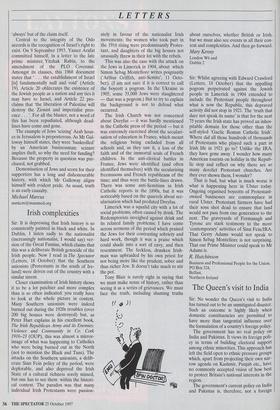Irish complexities
Sir: It is depressing that Irish history is so consistently painted in black and white. In Dublin, I listen sadly to the nationalist (increasingly nationalist, I would say) ver- sion of the Great Famine, which claims that this was a deliberate British genocide of the Irish people. Now I read in The Spectator (Letters, 18 October) that the Southern unionists (Protestants in the south of Ire- land) were driven out of the country with a similar intent.
Closer examination of Irish history shows it to be a lot patchier and more complex than is so often indicated: you really have to look at the whole picture in context. Many Southern unionists were indeed burned out during the 1920s troubles (over 200 big houses were destroyed) but, as Peter Hart explains in his excellent book, The Irish Republican Army and its Enemies: Violence and Community in Co. Cork 1916-23 (OUP), this was almost a mirror- image of what was happening to Catholics who were being burned out in the North (not to mention the Black and Tans). The attacks on the Southern unionists, a delib- erate Sinn Fein policy of the period, were deplorable, and also deprived the Irish State of a cultural richness sorely missed, but one has to see them within the histori- cal context. The paradox was that many individual Irish Protestants were passion- ately in favour of the nationalist Irish movements: the women who took part in the 1916 rising were predominantly Protes- tant, and daughters of the big houses not unusually threw in their lot with the rebels.
This was also the case with the attack on the Jews in Limerick in 1904, about which Simon Sebag Montefiore writes poignantly (Arthur Griffith, anti-Semite', 11 Octo- ber). (I am not sure if it is correct to call the boycott a pogrom. In the Ukraine in 1905, some 35,000 Jews were slaughtered — that was a pogrom.) But to try to explain the background is not to defend what occurred.
The Irish Church was not concerned about Dreyfus — it was hardly mentioned in the Catholic press of the period — but it was extremely exercised about the seculari- sation of education in France, which meant the religious being excluded from all schools and, as they saw it, a loss of the faith and of the immortal souls of French children. In the anti-clerical battles in France, Jews were identified (and often identified themselves) with the secularising freemasons and French republicans of the time; and thus were the battle-lines drawn. There was some anti-Semitism in Irish Catholic reports in the 1890s, but it was noticeably based on the quarrels about sec- ularisation which had predated Dreyfus.
Limerick was a squalid city with a lot of social problems, often caused by drink. The Redemptorists inveighed against drink and its related family problems; I have come across sermons of the period which praised the Jews for their contrasting sobriety and hard work, though it was a praise which could shade into a sort of envy, and then resentment. The feckless, drunken Irish- man was upbraided by his own priest for not being more like the prudent, sober and thus richer Jew. It doesn't take much to stir the pot.
Tony Blair is surely right in saying that we must make sense of history, rather than seeing it as a series of grievances. We must face the truth, including shaming truths about ourselves, whether British or Irish, but we must also see events in all their con- text and complexities. And then go forward. Mary Kenny London W6 and Dublin 2


















































































 Previous page
Previous page